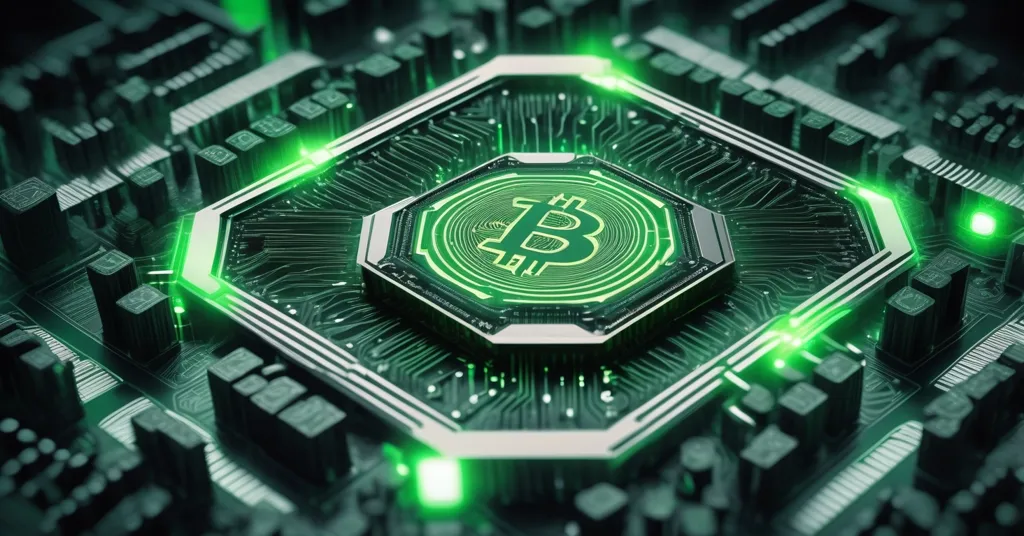AMD’s 2025 AI GPU Launch: A Game-Changer for Tech and Bitcoin’s Future

AMD Set to Disrupt AI Chip War by 2025: Ripple Effects for Bitcoin and Beyond
Advanced Micro Devices (AMD) is gearing up to shake the AI hardware landscape with shipments of its next-generation AI GPUs slated for the end of 2025. This isn’t just a tech milestone—it’s a bold move to challenge Nvidia’s dominance, re-enter the Chinese market with cutting-edge cloud infrastructure, and potentially lay computational groundwork that could resonate with Bitcoin and blockchain enthusiasts. As the AI chip race intensifies, let’s unpack what this means for tech disruption, decentralization, and even crypto’s energy-hungry ecosystem.
- AMD targets end of 2025 for next-gen AI GPU shipments, eyeing China with advanced cloud tech.
- AI accelerator market could hit $500 billion soon, says CEO Lisa Su, signaling massive growth.
- Competition rages as Huawei stumbles in emerging markets while Nvidia holds its ground.
AMD’s AI GPU Rollout: Powering the Future by 2025
AMD’s announcement to start shipping its cutting-edge AI GPUs, specifically the Instinct MI400 Series as part of the “Helios” rack system, by late 2025 marks a significant leap in the semiconductor race. For those new to the jargon, GPUs—or graphics processing units—are specialized chips built to handle complex tasks like rendering graphics or, in this case, training AI models. Rack systems are essentially large-scale hardware setups designed for high-performance computing in data centers. These chips, known as AI accelerators, are the engines behind everything from ChatGPT-style generative tools to autonomous driving tech, crunching massive datasets at speeds regular processors can’t match. AMD claims up to a 10x performance boost on certain AI models with this new lineup, positioning itself as a serious rival to Nvidia’s stranglehold on the market.
CEO Lisa Su, speaking at a recent AI event in Washington hosted by the All-In Podcast team, tied AMD’s future to this explosive sector.
“You can determine if we have done well by looking at what we accomplished in five years,”
she declared, projecting the AI accelerator market to surpass $500 billion in just a few years. That’s a staggering figure, reflecting how integral AI is becoming to industries and governments worldwide. But let’s not just take her word as gospel—industry trends back this up, with demand for AI infrastructure skyrocketing as businesses race to integrate machine learning and automation. Whether it’s Meta fine-tuning social algorithms or Elon Musk’s xAI pushing boundaries, AMD’s partnerships with these heavyweights show it’s not just playing catch-up; it’s aiming to lead. For more on the expected timeline, check out the latest updates on AMD’s first deliveries by yearend.
Production Costs and Geopolitical Quicksand: The Challenges Ahead
Not everything is coming up roses for AMD. A nagging issue is the cost of chip production. Chips made at Taiwan Semiconductor Manufacturing Co. (TSMC) facilities in the US carry a notable price bump—reportedly 5-20% higher—compared to those produced in Taiwan or elsewhere, a gap Su herself highlighted. Some analyses, like from TechInsights, suggest the difference might be tighter, under 10% for a standard 300mm wafer, with equipment costs, not labor, driving the bulk of expenses. As G. Dan Hutcheson of TechInsights put it, “Cost is important…value is decisive.” Strategic moves like the US CHIPS Act—a policy pumping billions into domestic semiconductor manufacturing to reduce reliance on foreign supply chains—might justify higher costs for security and geopolitical reasons. Still, for AMD, balancing efficiency with national interests is a tightrope walk. Dive deeper into the cost disparity between US and Taiwan chip production.
Then there’s the China gambit. AMD’s push to re-enter the Chinese market isn’t just about flogging chips; it’s about deploying top-tier cloud infrastructure to meet soaring AI demand. This pits them against Huawei Technologies, which is scrambling to carve out space in the Middle East and Southeast Asia with its Ascend 910B chip. Huawei’s getting stonewalled in places like the UAE—hardly a shocker given US alliances and security concerns—while negotiations in Saudi Arabia and Thailand remain murky. Supply constraints further kneecap Huawei, limiting exports and forcing odd workarounds like remote access to CloudMatrix 384, a Chinese AI system powered by its tech. Analyst Susan Li of Tech Horizons Institute calls Huawei’s play a potential “game-changer” for diversifying AI chip sources, but let’s be real: geopolitical quicksand and supply bottlenecks keep that dream on shaky ground. Will AMD’s China bet pay off, or are they wading into the same regulatory swamp? For the latest on Huawei’s efforts, see the status of their Ascend 910B expansion negotiations.
AMD vs. Nvidia vs. Huawei: A Silicon Slugfest
Zooming out, the AI chip arena is a no-holds-barred brawl. Nvidia remains the 800-pound gorilla, dominating market share, especially in regions like the Middle East where Huawei can’t get a foothold. AMD, though, is carving a niche with an open ecosystem—think open-source software like ROCm 7 and accessible developer clouds—that vibes with the decentralization ethos we Bitcoiners hold dear. Much like Bitcoin disrupted centralized finance, AMD’s scalable AI infrastructure could empower smaller players or decentralized networks by lowering barriers to high-performance computing. It’s not a direct blockchain play, but raw computational power is a shared need, whether you’re training neural nets or securing a proof-of-work chain. For a community perspective on this rivalry, explore discussions on AMD versus Nvidia in AI competition.
Geopolitically, this mirrors battles in the crypto world. The US-China tech rivalry—evident in Huawei’s export woes and TSMC’s cost disparities—echoes the regulatory tug-of-war over Bitcoin mining bans in China or SEC crackdowns stateside. Centralized powers meddling with disruptive tech is an old story, whether it’s silicon or sats. AMD’s collaborations with Meta, OpenAI, Microsoft, and xAI signal a united front to outpace rivals, much like Bitcoin maximalists and altcoin innovators begrudgingly coexist to push a financial revolution. But let’s not kid ourselves—competition breeds innovation, and this slugfest between AMD, Nvidia, and Huawei might just be the catalyst for breakthroughs we haven’t even imagined yet. To understand the broader context, look into the AI chip market growth and geopolitical challenges.
Energy Efficiency: A Quiet Win for Crypto Mining?
Here’s where things get juicy for our crowd. AMD has already obliterated its five-year goal of a 30x improvement in energy efficiency for AI training—hitting a wild 38x—and now aims for a 20x rack-scale efficiency boost by 2030. Energy consumption is the Achilles’ heel of crypto mining, especially for Bitcoin, where rigs guzzle electricity like there’s no tomorrow, drawing regulatory heat over environmental impact. AI workloads and mining share a hunger for computational muscle, even if their hardware designs differ. Could AMD’s efficiency tech inspire a new breed of Bitcoin mining hardware that slashes power costs without gutting hash rates? It’s not a direct crossover—AMD isn’t likely to pivot to specialized mining chips anytime soon—but the overlap in raw processing demands makes this a tantalizing space to watch. Curious about potential impacts? Check out insights on how AMD’s AI GPUs might influence Bitcoin mining.
Think about it: Bitcoin miners face skyrocketing electricity bills and bans in energy-strapped regions. If AMD’s advancements trickle into general-purpose computing or inspire similar gains in mining tech, it could ease one of crypto’s biggest pain points. Hell, even if it’s just powering nodes for layer-2 solutions or privacy-focused protocols with less juice, that’s a win for decentralization. We’re not saying it’s happening tomorrow, but the parallel between AI’s energy challenges and blockchain’s is too glaring to ignore.
Playing Devil’s Advocate: Is the Hype Real?
Before we get too starry-eyed, let’s pump the brakes. Su’s $500 billion market projection for AI accelerators sounds like a jackpot, but does it bank on endless demand or gloss over potential hiccups like economic downturns or market saturation? We’ve seen hype cycles in crypto—2017’s ICO insanity or 2021’s memecoin madness—where lofty predictions often smash into brutal reality. The AI chip boom could hit similar walls if adoption stalls or geopolitical flashpoints snarl global supply chains. And let’s be blunt: projecting market sizes years out is often more guesswork than gospel, a lesson Bitcoiners learned from endless “$1M BTC by next Tuesday” hot takes that flop. We’re rooting for the tech, not the crystal ball. For a comprehensive look at AMD’s broader GPU development history, refer to this detailed resource on AMD’s AI GPU advancements.
Another angle to chew on: is AMD’s laser focus on AI sidelining other innovations that could directly aid blockchain? Specialized mining hardware or chips tailored for consensus mechanisms aren’t on their radar, and maybe that’s fine—Bitcoin doesn’t need every tech giant holding its hand. But if resources poured into AI GPUs mean less attention on raw processing niches crypto could leverage, are we missing a trick? Then there’s the 2025 timeline itself—ambitious, sure, but realistic? Production cost hurdles and potential regulatory backlash in China could throw a wrench in the works. Optimism is our fuel, but skepticism keeps us grounded. For official updates on the timeline, see AMD’s 2025 AI GPU shipment confirmation.
Key Takeaways and Questions on AMD’s AI Push
- Why are AI chips in such high demand right now?
The surge comes from a need for AI accelerators to power cutting-edge applications like generative AI tools and autonomous systems, making them critical for tech innovation and positioning AMD as a key player. - What’s behind the higher cost of US-made chips at TSMC?
Chips from TSMC’s US facilities cost more—possibly 5-20% higher—due to factors like labor and regulations, though some data pegs the gap lower, showing strategic value often trumps raw economics. - How does AMD’s open ecosystem tie to decentralization?
With open-source software like ROCm 7 and developer clouds, AMD echoes Bitcoin’s decentralized spirit, potentially enabling smaller players or blockchain scalability through accessible high-performance computing. - What’s holding Huawei back in the AI chip race?
Huawei’s bogged down by supply constraints limiting exports, zero interest from markets like the UAE, and geopolitical tensions, making it tough to challenge Nvidia or AMD head-on. - Could AMD’s energy efficiency gains help Bitcoin mining?
AMD’s 38x efficiency boost for AI training hints at potential for energy-hungry crypto mining, though direct applications are speculative—shared computational needs make it a trend worth watching.
AMD’s 2025 timeline for AI GPU deliveries isn’t just a corporate checkbox—it’s a signpost for where tech disruption is barreling next. Whether it’s outmuscling Nvidia, navigating Huawei’s geopolitical mess, or quietly building computational muscle that could bolster a decentralized future, AMD is playing chess while others are still learning checkers. For us in the Bitcoin and crypto sphere, it’s a nudge that the silicon shaping AI today might just redefine blockchain’s battles tomorrow. Could AMD’s push inadvertently craft the backbone for a truly decentralized internet, or are we just dreaming in silicon? Chew on that as this saga unfolds.



